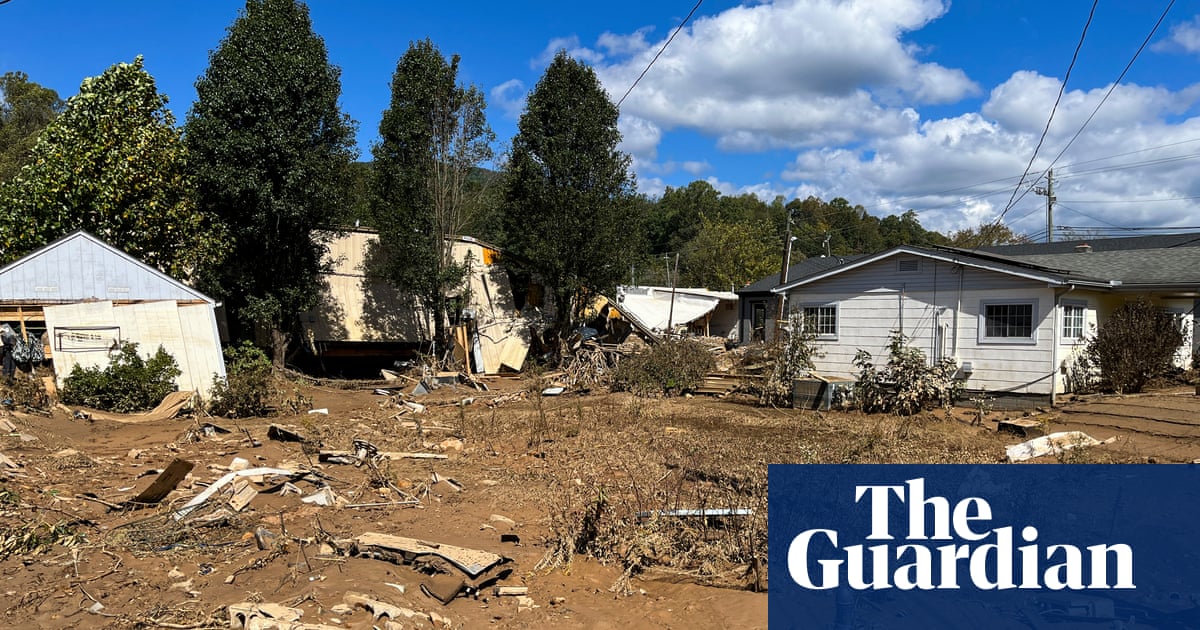Hurricane Helene took much from western North Carolina where I live, farm and raise my family. The stories are harrowing: houses obliterated by landslides, whole families washed away, corpses revealed as the waters receded.
Suddenly, there’s deep climate trauma here, in a place where we mistakenly thought hurricanes happened to Floridians and coastal communities, not us. Helene stole our sense of security: we now side-eye trees, which crushed homes, power lines, cars and people. And the rain, the farmer’s frequent wish, turned our rivers maniacal.
It’s not just a question of what Helene, now the nation’s deadliest hurricane since Katrina, took. It’s also a question of what it left behind: tons of soil, sediment and toxic sludge in places where it shouldn’t be – including covering our region’s farms.
In Marion, North Carolina, Chue and Tou Lee of Lee’s One Fortune Farm are Hmong farmers who grow rice (a rarity in the mountains), a wide assortment of Asian vegetables, and reportedly the best peaches in the region. When nearby Canoe Creek flooded, it drowned $60,000 of produce, a significant amount for any small farm to lose. Their lower field is now buried under almost 4ft (1.2 meters) of sand and sediment, which they’ll need a machine to move before replanting.
Sixty miles (97km) away in Hendersonville, Delia Jovel Dubón heads Tierra Fértil Coop, a Hispanic worker-owned farming co-operative. This season was to be its last sharing land with Tiny Bridge Farm, where the French Broad River crested 10ft higher than its Hurricane Frances peak in 2004. Twenty feet of water swallowed their fields, destroying all crops and washing away two greenhouses.
Ed Graves, one of Tiny Bridge’s owners, wrote on social media about the added work of looking for resources to help post-storm: “Our food system is such that people who feed their communities have to fundraise after disasters. We keep receipts and apply for all the things.” But, showing the optimism required of farmers, Graves said: “We still have topsoil so we have hope.”
Any farmer who understands sustainable, regenerative or organic agriculture practices will tell you that soil is life. It teems with microbes, bacteria, fungi, protozoa, nematodes, arthropods, other insects and animals. All that soil life has a deep relationship with the plants via their roots. The plants trade carbs and sugars for essential nutrients and water from the soil’s underground microbiology. This complex, invisible collaboration breaks down when soil is submerged, and life begins to die.
This die-off can lead to an effect known as post-flood syndrome, which describes the stunted growth of crops after soils have been water-logged. Flooding can be especially damaging to beneficial fungi, and that affects how plants can access phosphorus. The mineral is essential to plant growth, and its depletion can linger for seasons.
Patience, persistence and plant-based solutions
Barnardsville farmer Michael Rayburn is also the urban agriculture extension agent for Buncombe county, which experienced the most Helene-related fatalities of any North Carolina county. He lost his ginger crop, which he used for specialty products such as chips and infused sugar. Even so, he felt lucky, with no harm to his family or home and just a few inches of floodwater covering the ginger.
Still, it only takes a few inches to contaminate a crop. “We’re out in the country,” he said. “Every house upstream has a septic system and septic field that will have mixed fecal matter into the floodwaters.”
Microbes that can sicken humans and livestock seep into the soil and the crops themselves. The North Carolina State University Food Safety Repository lists E coli, listeria, Vibrio, salmonella, hepatitis A and norovirus as increased risks when eating produce from flooded gardens.
And this was no normal weather event (one water resource engineer went viral for saying that Helene was a “30,000-year storm”).
“Old houses turned to confetti, diesel tractors washed away like bath toys,” said Rayburn. “I stood on my porch and watched propane canisters and 300-gallon oil drums float by.” Effluent from wastewater plants, pesticides, herbicides, fuel and industrial chemicals all ended up in the water.
Thirty miles downstream in neighboring Madison county, the French Broad River inundated the downtown of Marshall (population about 800) with mud and debris. But the term “mud” is misleading. “Mud” is the rainy-day puddle we played in as kids. This is toxic sludge, plastered across roads and sidewalks, filling buildings and alleyways. The community called for personal protective gear – gloves, goggles, boots, respirators – simply so they could clean their town.
It’s a colossal task, cleaning a mud-flattened, toxic town center. How do farmers “clean” our fields? How does chemical-soaked soil grow anything again, let alone food?
“Everywhere is going to be different,” said Rayburn. “But remember, flooding is a natural process, so it’s not the end of the road.” Soil and water testing is going to be an important tool to establish what specific contaminants farmers will need to deal with (and how to protect themselves).
Plants themselves hold many of the solutions.
The current recommendation from Buncombe county extension, where Rayburn works, is to plant nothing but cover crops for at least 60 days after the flood event. “Let the shit sit,” said Rayburn.
Simple exposure to sunlight and the weather can be enough to break down or dilute many dangerous pathogens. The same is true of some chemicals like pesticides and herbicides. Cover crops include a wide range of grasses, legumes and brassica (a family of plants that includes radishes, mustard and many others). Their roots encourage the return of life within the soil, much like taking a probiotic after a course of antibiotics.
Other toxins like heavy metals will not break down over time. For these, soil testing and targeted remediation efforts will be critical. Again, plants can help. Phytoremediation is the process of planting crops like sunflower and mustard, which can pull arsenic, lead and cadmium from the soil and into their leaves. When the plants are removed, so are the toxins. Similarly, mycoremediation uses mushrooms to break down complex carbons like oil and diesel. This natural technology has been applied at various scales from contaminated soils in community gardens to large oil spills in the Amazon.
Soil remediation is one thing, but the physical cleanup is a daunting task with no easy or natural solutions. Helene mixed everything up like a blender. Soil and sludge cover towns, and broken towns are also strewn across farmlands.
Mark Dempsey, a doctoral candidate in lentil breeding and genetics at Clemson University, has a home and small urban farm in Swannanoa, North Carolina. His housemates were forced to swim from his house as floodwaters rapidly rose. Dempsey regularly teaches soil classes at farming conferences, and he’s a big proponent of cover cropping.
“I was actually getting ready to sow my fall cover crop,” Dempsey said, “but decided to wait until after Helene just in case the field flooded a little.” Never did he imagine that Swannanoa would be so devastated. The landscape is marked with piles of rubble, sand and trash, like the moraines of rock and sediment left in the wake of a glacier.
Dempsey quickly realized there was simply so much debris that a cover crop would just make cleanup harder. “There’s a new wrecked car in my garden,” he said. “And so much stuff. Just human junk everywhere. It’s going to take months.”
Dubón and her colleagues at Tierra Fértil Coop are in a similar position, and have already had one community cleanup day at Tiny Bridge Farm. “We have dealt with this in our own countries [of origin], and our priority is to recover. Always recover,” said Dubón. “If we stop to think of all the problems, we’ll be paralyzed.”
And they can only move so quickly: flood recovery is often a wait-and-see proposition. See how much damage they sustained as they clean up, see what’s in the soil, see what resources they can gather to rebuild.
Rayburn urges patience, as much as he gets the urgent need to do something. “I’m a farmer,” he said. “I understand the emotional connection to the land and the desire to return to how things were.” We even talked of an alluvial silver lining, noting the richest soils in the region are sandy bottomlands, near streams and rivers, which have benefited from layers of mineral rich flood deposits.
The land will heal. But in the meantime, farmers have no crops and therefore no income. Many are faced with a long and arduous recovery, relying on grants, loans and mutual aid to figure out the future.
The Lees want to replant as soon as possible to recoup their losses, Rayburn will follow his own advice of patience, cover crops and soil testing. As a hobby farmer, Dempsey lost his home but not his livelihood. Dubón and crew are committed to cleanup, but have other growing sites less affected.
Less than a month after the storm, many farmers are still just surviving day to day. Sass Ayres, farm manager of Mystic Roots Farm in Fairview, North Carolina, wrote online that it’s hard to tell that their farm ever existed.
“I don’t know what’s next. Though as a farmer, I do know that everything starts with a seed. It’s the magic on which we bet our hearts & livelihoods. Once the wreckage is cleared, I have faith that there’s a seed just waiting to burst open with life. Know that we hold this hope for all of us really tight. It’s what farmers do.”
Chris Smith is executive director of the Utopian Seed Project, a crop-trialing non-profit working to celebrate food and farming in western North Carolina.



